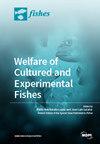Tropical Shrimp Biofloc Aquaculture within Greenhouses in the Mediterranean: Preconditions, Perspectives, and a Prototype Description
IF 2.1
3区 农林科学
Q2 FISHERIES
引用次数: 0
Abstract
Biofloc technology (BFT) offers an innovative eco-friendly approach that is particularly applicable in shrimp farming. Penaeus vannamei is the most important seafood species in terms of global economic value. Nevertheless, its increasing global demand highlights the necessity for sustainable production of P. vannamei shrimps outside their native range, assuring the avoidance of genetic pollution risk. Towards this direction, the present study focuses on the feasibility of tropical shrimp species aquaculture in indoor systems evaluating BFT application in temperate zones. The achievability of P. vannamei cultivation inside greenhouses in temperate latitudes is thoroughly examined and a representative experimental biofloc setup for P. vannamei within a greenhouse in Northern Greece is demonstrated. Nevertheless, there are two major limitations, related to economy and ecology, namely the energy demand for high seawater temperature and the fact that most reared shrimps are non-indigenous species setting risk for genetic pollution, respectively. To overcome the former, energy-saving measures such as tank and greenhouse insulation in combination with a microclimate chamber construction were implemented to optimize water temperature at minimal cost. Concerning the latter, there is clear evidence that P. vannamei populations cannot be established in the Mediterranean, setting aside any environmental risk. Overall, based on the developed and tested pilot prototype, employment of optimal management practices, innovative manufacturing and clean energy alternatives, and the utilization of ecosystem services could reduce the environmental impact and maximize the profitability of biofloc operations. These actions could probably permit sustainable and economically viable farming of P. vannamei employing BFT within greenhouses in the Mediterranean.地中海温室内的热带虾生物絮团水产养殖:前提条件、前景和原型描述
生物絮团技术(BFT)提供了一种创新的生态友好型方法,尤其适用于对虾养殖。就全球经济价值而言,凡纳滨对虾是最重要的海产品物种。然而,全球对该物种的需求日益增长,这就凸显了在凡纳滨对虾的原产地以外进行可持续生产的必要性,以确保避免遗传污染风险。朝着这个方向,本研究重点关注在室内系统中养殖热带对虾物种的可行性,评估 BFT 在温带地区的应用。本研究对在温带温室内养殖凡纳滨对虾的可行性进行了深入研究,并展示了在希腊北部温室内养殖凡纳滨对虾的生物絮团实验装置。然而,在经济和生态方面存在两大局限性,即海水温度过高对能源的需求,以及大多数饲养的对虾都是非本地物种,存在遗传污染的风险。为了克服前者,采取了一些节能措施,如水箱和温室隔热以及建造微气候室,以最小的成本优化水温。关于后者,有明确证据表明,抛开任何环境风险不谈,凡纳米鱼种群无法在地中海地区建立。总之,根据开发和测试的试点原型,采用最佳管理方法、创新制造和清洁能源替代品,以及利用生态系统服务,可以减少对环境的影响,并最大限度地提高生物絮团操作的盈利能力。这些措施可能会使地中海地区在温室中使用生物絮团养殖凡纳滨对虾成为可持续的、经济上可行的养殖方式。
本文章由计算机程序翻译,如有差异,请以英文原文为准。
求助全文
约1分钟内获得全文
求助全文
文献相关原料
| 公司名称 | 产品信息 | 采购帮参考价格 |
|---|

 求助内容:
求助内容: 应助结果提醒方式:
应助结果提醒方式:


